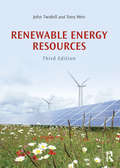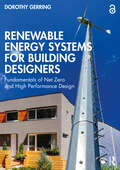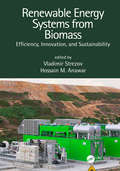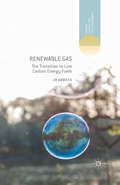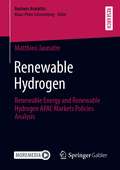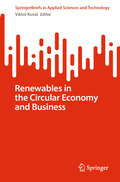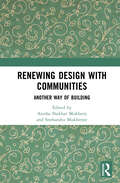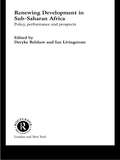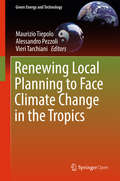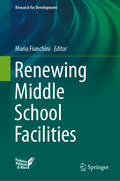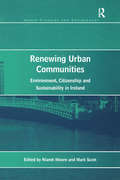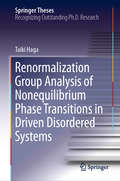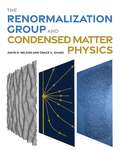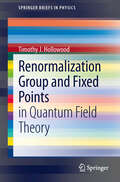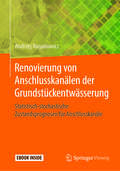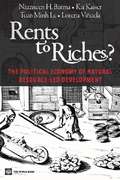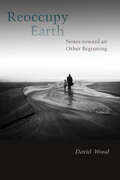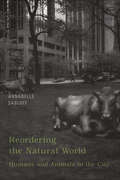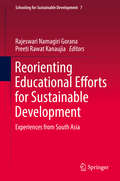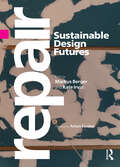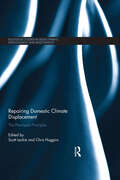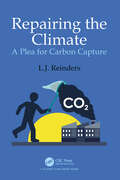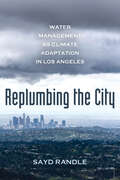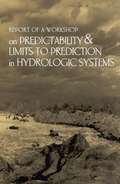- Table View
- List View
Renewable Energy Resources
by John Twidell Tony WeirRenewable Energy Resources is a numerate and quantitative text covering the full range of renewable energy technologies and their implementation worldwide. Energy supplies from renewables (such as from biofuels, solar heat, photovoltaics, wind, hydro, wave, tidal, geothermal, and ocean-thermal) are essential components of every nation’s energy strategy, not least because of concerns for the local and global environment, for energy security and for sustainability. Thus in the years between the first and this third edition, most renewable energy technologies have grown from fledgling impact to significant importance because they make good sense, good policy and good business. This Third Edition is extensively updated in light of these developments, while maintaining the book’s emphasis on fundamentals, complemented by analysis of applications. Renewable energy helps secure national resources, mitigates pollution and climate change, and provides cost effective services. These benefits are analysed and illustrated with case studies and worked examples. The book recognises the importance of cost effectiveness and efficiency of end-use. Each chapter begins with fundamental scientific theory, and then considers applications, environmental impact and socio-economic aspects before concluding with Quick Questions for self-revision and Set Problems. The book includes Reviews of basic theory underlying renewable energy technologies, such as electrical power, fluid dynamics, heat transfer and solid-state physics. Common symbols and cross-referencing apply throughout; essential data are tabulated in appendices. An associated eResource provides supplementary material on particular topics, plus a solutions guide to Set Problems. Renewable Energy Resources supports multi-disciplinary master degrees in science and engineering, and specialist modules in first degrees. Practising scientists and engineers who have not had a comprehensive training in renewable energy will find it a useful introductory text and a reference book.
Renewable Energy Systems for Building Designers: Fundamentals of Net Zero and High Performance Design
by Dorothy GerringRenewable Energy Systems for Building Designers presents a comprehensive introduction to the latest resources and technologies used in high performance and net zero energy buildings, with a practical focus on the design and integration of these systems. This textbook and convenient reference offers a single-source guide to renewable technologies, balancing broad knowledge with the details of implementation crucial for successful sustainable design. It equips students and professionals with foundations and critical information needed to confidently plan for and meet the highest standards of energy efficiency in new construction and retrofitted buildings. Part I of the book establishes key principles of renewable systems, power production, and design for climate, introducing energy modeling and measurements of performance. Part II focuses in more depth on renewable energy systems, including photovoltaics, heat pumps, solar thermal, and more. Dedicated chapters break down the fundamental concepts behind each renewable technology and present guidelines for configuration and installation including system requirements, equipment specification, sizing, and location of components. Part III discusses topics relevant across renewable systems, including energy storage, control and monitoring, and cost/payback calculation. Part IV comprises case studies of exemplary renewable energy projects. Features: Covers resources and technologies including photovoltaics, solar thermal hot water, heat pumps, biomass, wind and microhydro turbines, marine renewable energy, deep cycle rechargeable batteries, and system controllers. Compiles up-to-date, essential information on designing with renewable systems in one location, organized by technology for easy reference. Presents clear explanations of all concepts and system aspects, using US/SI units and full-color diagrams and illustrations throughout. Features case studies of renewable energy systems in completed projects, demonstrating a range of climate specific applications. Includes study questions, a comprehensive guide to terminology and acronyms, spreadsheets for calculations, system sizing worksheets, and additional online resources. Renewable Energy Systems for Building Designers: Fundamentals of Net Zero and High Performance Design will serve as an essential introduction and enduring reference for students of architecture, engineering, construction, and building science. Equally valuable as a professional resource, it will quickly become the go-to guide for energy efficient design for practitioners in these areas.
Renewable Energy Systems from Biomass: Efficiency, Innovation and Sustainability
by Vladimir Strezov and Hossain M. AnawarNew innovations are needed for the invention of more efficient, affordable, sustainable and renewable energy systems, as well as for the mitigation of climate change and global environmental issues. In response to a fast-growing interest in the realm of renewable energy, Renewable Energy Systems: Efficiency, Innovation and Sustainability identifies a need to synthesize relevant and up-to-date information in a single volume. This book describes a systems approach to renewable energy, including technological, political, economic, social and environmental viewpoints, as well as policies and benefits. This unique and concise text, encompassing all aspects of the field in a single source, focuses on truly promising innovative and affordable renewable energy systems. Key Features: Focuses on innovations in renewable energy systems that are affordable and sustainable Collates the most relevant and up-to-date information on renewable energy systems, in a single and unique volume Discusses lifecycle assessment, cost and availability of systems Emphasizes bio-related topics Provides a systems approach to the renewable energy technologies and discusses technological, political, economic, social, and environmental viewpoints as well as policies
Renewable Gas: The Transition to Low Carbon Energy Fuels (Energy, Climate and the Environment)
by Jo AbbessThe author looks at the prospects for a transition from natural gas to low carbon gas, which could take several decades, and at how this will depend on the evolution of the fossil fuel industry. She investigates the technologies and energy systems for making the best use of renewable gas resources.
Renewable Hydrogen: Renewable Energy and Renewable Hydrogen APAC Markets Policies Analysis (Business Analytics)
by Matthieu JaunatreHydrogen has recently become a popular topic and is often described as the missing link to a successful green energy transition. However, hydrogen can only contribute to a carbon-free future if it is produced from renewable energy. The ability to produce renewable hydrogen is linked to the renewable energy production capacity, which is itself conditioned by the underpinning renewable energy policies. This publication offers a review and an analysis of the renewable energy and hydrogen policies of five countries of the APAC markets: Australia, China, Japan, South-Korea and Taiwan. The review is complemented by interviews of renewable energy policy experts, renewable energy project developers and potential renewable hydrogen off-takers. Altogether, the policies analysis and experts’ inputs provide a comprehensive overview of the status, drivers, limitations, and recommendations for the use of renewable hydrogen as a solution for deep decarbonization. Finally, the author proposes a method to assess the potential of renewable hydrogen to decarbonize hard-to-abate industries (ammonia, methanol, oil refining and steel manufacturing) based on existing renewable energy policies.
Renewables in the Circular Economy and Business (SpringerBriefs in Applied Sciences and Technology)
by Viktor KovalThis book is an interdisciplinary study linking the circular economy and renewable energy, satisfying the public interest in sustainable energy solutions from a social, political, economic, and technological perspective. The book considers all subjects that can help solve the problems of creating a sustainable energy system through the production of clean energy with integration into the national energy system without compromising reliability and improving energy security.
Renewing Cities with Value Capture Planning: Model for Achieving Equitable Housing, Public and Open Spaces, and Sustainable Transport
by Raymond RauscherThe book offers a model for city development and renewal based on land value capture (called ‘value capture’). Firstly, a review is presented of cities around the world that are currently using value capture. From these city examples the author shows how any state, city or regional government can adopt value capture policies. Looking at recent events the author reviews the implications of the coronavirus pandemic (2020) for future planning (including value capture) of cities and regions (particularly noting healthy cities planning). The development of a value capture planning (VCP) model is then outlined. The basis of the model is reflected in its planning components, being: Housing (affordable, social and market housing); Public and Open Spaces (natural areas, open spaces and public spaces); and, Sustainable Transport (rail, bus, and active transport). The VCP model is devised to provide an economic and planning tool that can be utilised in addressing each of these planning components. This tool includes data entry tables and explanations of how these tables are applied. Four case study cities (within Australia) currently undergoing renewal are selected for the model to be applied to. The areas were chosen to represent contrasting urban settings and types of development and renewal, including: inner city, middle ring city; growth centre city; and, regional capital city. The current (2020) active renewal programs within these areas include (city in brackets): Central to Eveleigh Renewal Area (CERA) (City of Sydney); Sydenham to Bankstown Urban Renewal Corridor (SBURC) (Canterbury Bankstown City); Gosford City Centre Revitalisation (GCCR) area (Gosford City); and, Newcastle City Renewal Area (NCRA) (Newcastle City). The reader is walked through (graphically) the backgrounds of these case study cities, including geography, development trends and details of renewal plans. Conclusions on the VCP model application are outlined for each study area (within that chapter) and for the cumulative results across all study areas (final chapter). With these conclusions, the application of the model to any city or region anywhere in the world is outlined. Finally, on a practical level the reader would be interested in how value capture is administered through programs (including the roles of government, developers and the community). Summing up, the book offers the reader an understanding of current city planning and the tools (like value capture) that will be required for future planning.
Renewing Design with Communities: Another Way of Building
by Anisha Shekhar Mukherji and Snehanshu MukherjeeThis book looks at alternative ways of analyzing traditional and contemporary architectural design and building practices in South Asia with a special focus on India. It showcases how collaborative projects between architects and local communities and drawing from local building traditions can lead to sustainable and equitable practices in architecture. The volume includes an analysis of projects in rural, tribal, and urban areas of India and Nepal and first-hand accounts of architects, teachers, and professionals engaged in the theory and practice of design and architecture. It examines the differences between the individualistic and the collective approach and explores the meaning of architecture as a process and as a product and as a decentralized, ecologically, and locally sensitive way of designing. While comparing traditional and modern methods of building, it also examines the impact of each method on the community, the economy and the surrounding environment. This book will be of interest to researchers and students of architecture, urban studies, urban planning, urban ecology, urban geography, and sustainable development. It will also be useful for architects, planners, urban designers, and professionals associated with these disciplines.
Renewing Development in Sub-Saharan Africa: Policy, Performance and Prospects
by Deryke Belshaw Ian LivingstoneRenewing Development in Sub-Saharan Africa reviews the debates and brings together specialist contributions, to provide a clear guide to the major complexities of African development. They lay the foundation for designing a range of individual country-specific policy-sets, in which the strategic components are prioritized according to each country's constraints and opportunities. The emphasis of the book is on the identification of effective strategies that will enable individual countries to most effectively exploit their growth opportunities and to meet poverty-reducing and other key equity objectives.
Renewing Local Planning to Face Climate Change in the Tropics
by Vieri Tarchiani Alessandro Pezzoli Maurizio TiepoloThis book is open access under a CC BY 4. 0 license. This book aims to inspire decision makers and practitioners to change their approach to climate planning in the tropics through the application of modern technologies for characterizing local climate and tracking vulnerability and risk, and using decision-making tools. Drawing on 16 case studies conducted mainly in the Caribbean, Central America, Western and Eastern Africa, and South East Asia it is shown how successful integration of traditional and modern knowledge can enhance disaster risk reduction and adaptation to climate change in the tropics. The case studies encompass both rural and urban settings and cover different scales: rural communities, cities, and regions. In addition, the book looks to the future of planning by addressing topics of major importance, including residual risk integration in local development plans, damage insurance and the potential role of climate vulnerability reduction credits. In many regions of the tropics, climate planning is growing but has still very low quality. This book identifies the weaknesses and proposes effective solutions.
Renewing Middle School Facilities (Research for Development)
by Maria FianchiniThis book draws on important original transdisciplinary research to address a wide range of issues relating to the remodeling of existing schools for pre-teenagers to fit them to various novel teaching models (e.g. collaborative learning, ICT integration, and out-of-classroom working) and to create effective educational environments for the future.The strong relationship between people’s wellbeing, physical environment and student learning in schools has already been extensively studied in international research. At the same time, a number of different scenarios of possible innovations are now emerging, and these require conscious choices in terms of designing both the ways and the places where educational processes can be developed.The principal focus of this research was the relationship between infrastructure, activities, and school communities.The book is divided into three sections, the first of which discusses conceptual aspects and outlines innovative renewal strategies. The second section describes a participatory research process developed in five case studies of lower-secondary or middle schools with the aim of updating our knowledge about such schools and identifying emerging issues. The last section presents case studies, operational tools, and design strategies that aid decision-making and support interventions to renew school facilities. The book is intended mainly for scholars of architecture and education, but is also of interest to a wider readership, including principals, teachers, designers, decision-makers in school communities, and heads of municipal education departments.
Renewing Urban Communities: Environment, Citizenship and Sustainability in Ireland (Urban Planning and Environment)
by Mark ScottIreland is now an urban society, and both parts of the island have experienced rapid urban-generated growth and new patterns of development in recent years. This inter-disciplinary book adopts an all-Ireland perspective to investigate the tension that exists between sustainable urban development values and rhetoric - such as increased densities, brown field development, the compact city and social inclusion - and the emerging geography of urban Ireland, influenced by consumer and lifestyle choices. The introduction provides an overview of the dynamics of urban change, particularly during the 1990s, and the experience of rapid economic growth. The following chapters are divided into two parts, considering sustainable urban environments, and sustainable communities. This book will appeal to students, academics, policy and decision-makers, given that it adopts both a qualitative and quantitative approach, and introduces a range of new empirical studies covering both physical and social sustainable development.
Renormalization Group Analysis of Nonequilibrium Phase Transitions in Driven Disordered Systems (Springer Theses)
by Taiki HagaThis book investigates phase transitions and critical phenomena in disordered systems driven out of equilibrium. First, the author derives a dimensional reduction property that relates the long-distance physics of driven disordered systems to that of lower dimensional pure systems. By combining this property with a modern renormalization group technique, the critical behavior of random field spin models driven at a uniform velocity is subsequently investigated. The highlight of this book is that the driven random field XY model is shown to exhibit the Kosterlitz–Thouless transition in three dimensions. This is the first example of topological phase transitions in which the competition between quenched disorder and nonequilibrium driving plays a crucial role. The book also includes a pedagogical review of a renormalizaion group technique for disordered systems.
The Renormalization Group and Condensed Matter Physics
by David R. Nelson Grace H. ZhangA graduate-level entrée to the application of renormalization group theory to condensed matter physicsRenormalization group ideas have had a major impact on condensed matter physics for more than a half century. This book develops the theory and illustrates the broad applicability of the renormalization group to major problems in condensed matter physics. Based on course materials developed and class-tested by the authors at Harvard University, the book will be especially useful for students, as well as researchers in condensed matter physics, soft matter physics, biophysics, and statistical physics. After reviewing Ising models, lattice gases, and critical point phenomena, the book covers quantum critical phenomena; the statistical mechanics of linear polymer chains; fluctuating sheet polymers; the dynamics associated with the Navier-Stokes equations and simplified models of randomly stirred fluids; the properties of &“active matter&”; and more.Explores the broad applicability of renormalization groups to condensed matterCovers critical phenomena in different dimensions, quantum critical points, polymer physics and flexural phonons in free-standing graphene, nonequilibrium fluid dynamics, and moreProvides a modern, physics-centered entrée, suitable for both course use and self-studyFeatures material ideal for graduate-level students as well as researchersIncludes exercises throughoutOffers a solutions manual for exercises (available only to instructors)
Renormalization Group and Fixed Points
by Timothy J HollowoodThis Brief presents an introduction to the theory of the renormalization group in the context of quantum field theories of relevance to particle physics. Emphasis is placed on gaining a physical understanding of the running of the couplings. The Wilsonian version of the renormalization group is related to conventional perturbative calculations with dimensional regularization and minimal subtraction. An introduction is given to some of the remarkable renormalization group properties of supersymmetric theories.
Renovierung von Anschlusskanälen der Grundstückentwässerung: Statistisch-stochastische Zustandsprognosen für Anschlusskanäle
by Andrzej RaganowiczDas Buch gibt eine Anleitung für das komplette Sanierungsspektrum, beginnend bei Grundstücksanschlüssen über die Zustandserfassung, Bewertung, Planung und die Ausführung der Renovierungsarbeiten bis zur Abnahme der Baumaßnahme sowie Gewährleistungsabnahme.
Rents to Riches? The Political Economy of Natural Resource-Led Development
by Naazneen H. Barma Kai Kaiser Tuan Minh Le Lorena ViñuelaThis volume focuses on the political economy surrounding the detailed decisions that governments make at each step of the value chain for natural resource management. From the perspective of public interest or good governance, many resource-dependent developing countries pursue apparently short-sighted and sub-optimal policies in relation to the extraction and capture of resource rents, and to spending and savings from their resource endowments. This work contextualizes these micro-level choices and outcomes.
Reoccupy Earth: Notes toward an Other Beginning (Groundworks: Ecological Issues in Philosophy and Theology)
by David WoodHabit rules our lives. And yet climate change and the catastrophic future it portends, makes it clear that we cannot go on like this. Our habits are integral to narratives of the good life, to social norms and expectations, as well as to economic reality. Such shared shapes are vital. Yet while many of our individual habits seem perfectly reasonable, when aggregated together they spell disaster. Beyond consumerism, other forms of life and patterns of dwelling are clearly possible. But how can we get there from here? Who precisely is the ‘we’ that our habits have created, and who else might we be? Philosophy is about emancipation—from illusions, myths, and oppression. In Reoccupy Earth, the noted philosopher David Wood shows how an approach to philosophy attuned to our ecological existence can suspend the taken-for-granted and open up alternative forms of earthly dwelling. Sharing the earth, as we do, raises fundamental questions about space and time, place and history, territory and embodiment—questions that philosophy cannot directly answer but can help us to frame and to work out for ourselves. Deconstruction exposes all manner of exclusion, violence to the other, and silent subordination. Phenomenology and Whitehead’s process philosophy offer further resources for an ecological imagination. Bringing an uncommon lucidity, directness, and even practicality to sophisticated philosophical questions, Wood plots experiential pathways that disrupt our habitual existence and challenge our everyday complacency. In walking us through a range of reversals, transformations, and estrangements that thinking ecologically demands of us, Wood shows how living responsibly with the earth means affirming the ways in which we are vulnerable, receptive, and dependent, and the need for solidarity all round.If we take seriously values like truth, justice, and compassion we must be willing to contemplate that the threat we pose to the earth might demand our own species’ demise. Yet we have the capacity to live responsibly. In an unfashionable but spirited defense of an enlightened anthropocentrism, Wood argues that to deserve the privileges of Reason we must demonstrably deploy it through collective sustainable agency. Only in this way can we reinhabit the earth.
Reordering the Natural World: Humans and Animals in the City
by Annabelle SabloffIn Reordering the Natural World, Annabelle Sabloff argues that the everyday practices of contemporary capitalist society reinforce the conviction that we are profoundly alienated from the rest of nature. At the same time, she reveals the often disguised affinities and sense of connection urban Canadians manifest in their relations with animals and the natural world.Sabloff reflects on how the discipline of anthropology has contributed to the prevailing Western perception of a divide between nature and culture. She suggests that the present ecological crisis has resulted largely from the ways in which Western societies have construed nature as a cultural system. Since new ideas about nature may be critical in changing humanity's destructive interactions with the biosphere, Reordering the Natural World is invaluable in exploring how urban Canadians develop and sustain their current relationship with the macrocosm, and in considering whether these relationships might be altered by reconceptualizing anthropology itself as an integral part of natural history. With this unique text, Sabloff not only provides provocative insight into the study of relations between humans and the natural world, she lays the cornerstone for building an entirely new structure for the study of anthropology itself.
Reorienting Educational Efforts for Sustainable Development
by Rajeswari Namagiri Namagiri Gorana Preeti Rawat Rawat KanaujiaEducation in South Asia has a renewed agenda which can enable societies to leapfrog development that is sustainable such that the individual is prepared for his/her involvement, responsibility and commitment to local and global discussions of our common future. This book on South Asia will focus on initiatives under the Education for Sustainable Development (ESD) umbrella and discuss the challenges, opportunities, issues and strategies in the countries of the region. It presents these initiatives of Environmental Education/ESD vis-à-vis the administrative, economic, social, cultural and ecological realities of each country at various levels of policy, planning, implementation and evaluation. The discussions in this book extend beyond formal education systems like schools, higher education, pre-service and in-service teacher preparation to community education and education initiatives conceptualized with the goal of sustainability. All initiatives will demonstrate how each country in its own pace contributing to move ESD from the periphery to the core of education initiatives.
Repair: Sustainable Design Futures
by Markus Berger Kate IrvinA collection of timely new scholarship, Repair: Sustainable Design Futures investigates repair as a contemporary expression of empowerment, agency, and resistance to our unmaking of the world and the environment. Repair is an act, metaphor, and foundation for opening up a dialogue about design’s role in proposing radically different social, environmental, and economic futures. Thematically expansive and richly illustrated, with over 125 visuals, this volume features an international, interdisciplinary group of contributors from across the design spectrum whose voices and artwork speak to how we might address our broken social and physical worlds. Organized around reparative thinking and practices, the book includes 30 long and short chapters, photo essays, and interviews that focus on multiple responses to fractured systems, relationships, cities, architecture, objects, and more. Repair will encourage students, academics, researchers, and practitioners in art, design and architecture practice and theory, cultural studies, environment and sustainability, to discuss, engage, and rethink the act of repair and its impact on our society and environment.
Repairing Domestic Climate Displacement: The Peninsula Principles (Routledge Studies in Development, Displacement and Resettlement)
by Scott Leckie Chris HugginsClimate change, sometimes thought of as a problem for the future, is already impacting people’s lives around the world: families are losing their homes, lands and livelihoods as a result of sea level rise, increased frequency and intensity of storms, drought and other phenomena. Following several years of preparatory work across the globe, legal scholars, judges, UN officials and climate change experts from 11 countries came together to finalise a new normative framework aiming to strengthen the right of climate-displaced persons, households and communities. This resulted in the approval of the Peninsula Principles on Climate Displacement within States in August 2013. This book provides detailed explanations and interpretations of the Peninsula Principles and includes in-depth discussion of the legal, policy and programmatic efforts needed to uphold the standards and norms embedded in the Principles. The book provides policy-makers with the conceptual understanding necessary to ensure that national-level policies are in place to respond to the climate displacement challenge, as well as a firm sense of the programme-level approaches that can be taken to anticipate, reduce and manage climate displacement. It also provides students and policy advocates with the necessary information to debate and critique responses to climate displacement at different levels. Drawing together key thinkers in the field, this volume will be of great relevance to scholars, lawyers, legal advisors and policy-makers with an interest in climate change, environmental policy, disaster management and human rights law and policy.
Repairing the Climate: A Plea for Carbon Capture
by L.J. ReindersClimate change is triggered by a too high concentration of greenhouse gases in the air, carbon dioxide in particular, primarily originating from fossil fuel-burning. Since such burning will not stop any time soon, the concentration will undoubtedly rise further, exacerbating climate change. There is no escape from this. That is where carbon capture comes in: direct air capture (DAC) scrubs the surplus carbon dioxide out of the air for actually lowering this concentration. At the same time emission levels must be drastically lowered by fitting point-source emitters with carbon capture installations. This book sets out the case for such carbon capture, which is a must, without which the climate cannot be repaired.
Replumbing the City: Water Management as Climate Adaptation in Los Angeles
by Sayd RandleMoving between shower drains, aqueducts, rain gardens, and even kitchen sinks, Replumbing the City traces the enormous urban waterscape of Los Angeles in a state of flux. For more than a century, the city of Los Angeles has relied on faraway water for the vast majority of its municipal supply, but climate change is making these distant sources much less dependable. To adapt, Angelenos—including city engineers, advocates at NGOs, and residents—are developing new water supplies within the space of the city. Sayd Randle’s ethnography examines the labor of replumbing LA’s sprawling water system, detailing how a desire to sustain unlimited and uninterrupted water provision for paying customers is reshaping the urban environment and its management. Tracking how such projects redistribute the work of water management, the book explores thorny questions of how the labor of climate adaptation should be mobilized and valued.
REPORT OF A WORKSHOP on PREDICTABILITY & LIMITS-TO-PREDICTION in HYDROLOGIC SYSTEMS
by Committee on Hydrologic ScienceREPORT OF A WORKSHOP on PREDICTABILITY & LIMITS-TO-PREDICTION in HYDROLOGIC SYSTEMS
